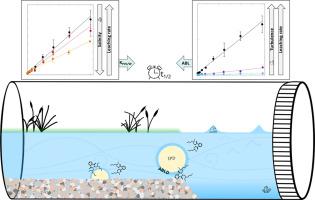Water Research ( IF 11.4 ) Pub Date : 2023-06-15 , DOI: 10.1016/j.watres.2023.120235 Charlotte Henkel 1 , Jonas Lamprecht 2 , Thorsten Hüffer 3 , Thilo Hofmann 3

|
Phthalic acid esters (phthalates) are an important group of additives (plasticizers) to ensure the flexibility and stability especially of polyvinyl chloride (PVC) and to enable its processing. However, phthalates like di(2-ethylhexyl) phthalate (DEHP) are harmful for aquatic organisms due to their endocrine disrupting effects and toxicity. For the assessment of exposure concentrations, thorough understanding of leaching kinetics of phthalates from PVC (micro-) plastics into aqueous environments is necessary. This study investigates how environmental factors influence the leaching of phthalates from PVC microplastics into aquatic systems. The leaching of phthalates from PVC microplastics into aqueous media is limited by aqueous boundary layer diffusion (ABLD) and thus, process-specific parameters can be affected by environmental factors such as salinity and the flow conditions. We conducted batch leaching experiments to assess the influence of salinity and flow conditions (turbulence) on the leaching of DEHP from PVC microplastics into aqueous media. DEHP is salted out with increasing salinity of the solution and a salting-out coefficient for DEHP of 0.46 was determined. The partitioning coefficient of DEHP between PVC and water KPVC/W increased with increasing salinity from 108.52 L kg−1 in a 1 mM KCl solution to 108.75 L kg−1 in artificial seawater thereby slowing down leaching. Increasing flow velocities led to higher leaching rates because the ABL thickness decreased from 1315 µm at 0 rpm shaking speed (no-flow conditions) to 38.4 µm at 125 rpm (turbulent conditions). Compared to salinity, turbulence had a more pronounced effect on leaching. Increasing the flow velocity led to a 35-fold decrease in the leaching rate, while increasing salinity led to a 2-fold increase. By calculating specific leaching times, that is, leaching half-lives (t1/2), time frames for leaching in different aquatic systems such as rivers and the ocean were determined. Given ABLD-limited leaching, DEHP is leached faster from PVC microplastics in rivers (t1/2 > 49 years) than in the ocean (t1/2 > 398 years). In both systems, PVC microplastics are a long-term source of phthalates.
中文翻译:

环境因素强烈影响聚氯乙烯微塑料中邻苯二甲酸二(2-乙基己基)酯的浸出
邻苯二甲酸酯(邻苯二甲酸酯)是一组重要的添加剂(增塑剂),可确保柔韧性和稳定性,尤其是聚氯乙烯 (PVC) 的柔韧性和稳定性,并使其能够加工。然而,邻苯二甲酸二(2-乙基己基)酯(DEHP)等邻苯二甲酸盐由于其内分泌干扰作用和毒性而对水生生物有害。为了评估暴露浓度,必须彻底了解邻苯二甲酸盐从 PVC(微)塑料浸出到水性环境中的动力学。本研究调查了环境因素如何影响邻苯二甲酸盐从 PVC 微塑料中浸出到水生系统中。邻苯二甲酸盐从 PVC 微塑料浸出到水性介质中受到水性边界层扩散 (ABLD) 的限制,因此,特定工艺参数可能会受到盐度和流动条件等环境因素的影响。我们进行了批量浸出实验,以评估盐度和流动条件(湍流)对 DEHP 从 PVC 微塑料浸出到水性介质中的影响。DEHP 随着溶液盐度的增加而盐析,测得 DEHP 的盐析系数为 0.46。DEHP在PVC和水之间的分配系数K PVC /W随着盐度的增加而增加,从1 mM KCl溶液中的10 8.52 L kg -1到人工海水中的10 8.75 L kg -1,从而减缓浸出。增加流速导致更高的浸出率,因为 ABL 厚度从 0 rpm 振荡速度(无流动条件)下的 1315 µm 降低到 125 rpm(湍流条件)下的 38.4 µm。与盐度相比,湍流对浸出的影响更为明显。增加流速导致浸出率下降 35 倍,而增加盐度则导致浸出率增加 2 倍。通过计算具体的浸出时间,即浸出半衰期(t 1/2),确定了在不同水生系统(例如河流和海洋)中浸出的时间范围。鉴于 ABLD 限制浸出,DEHP 在河流(t 1/2 > 49 年)中从 PVC 微塑料中浸出的速度 比在海洋(t 1/2 > 398 年)中更快。在这两个系统中,PVC 微塑料都是邻苯二甲酸盐的长期来源。






























 京公网安备 11010802027423号
京公网安备 11010802027423号